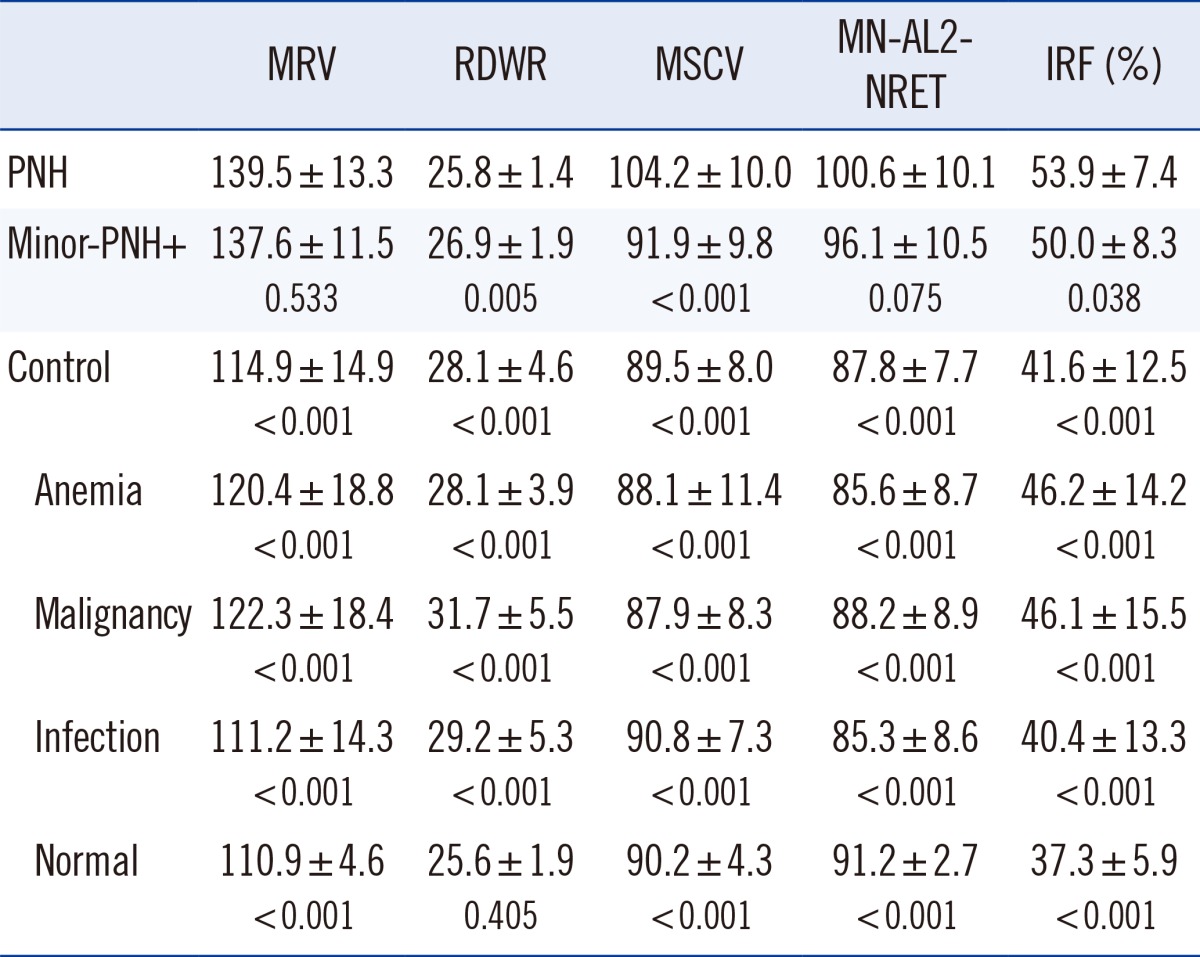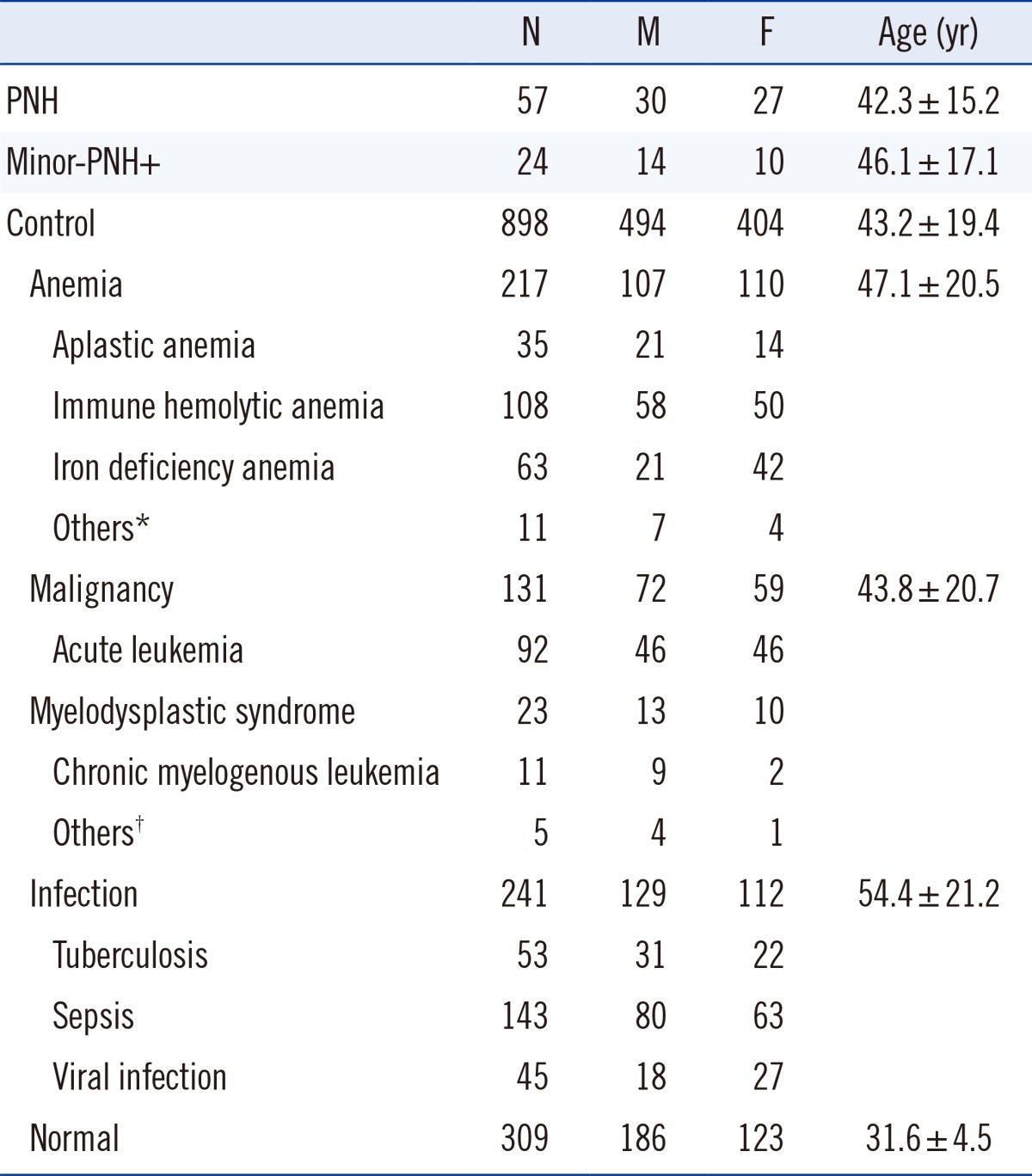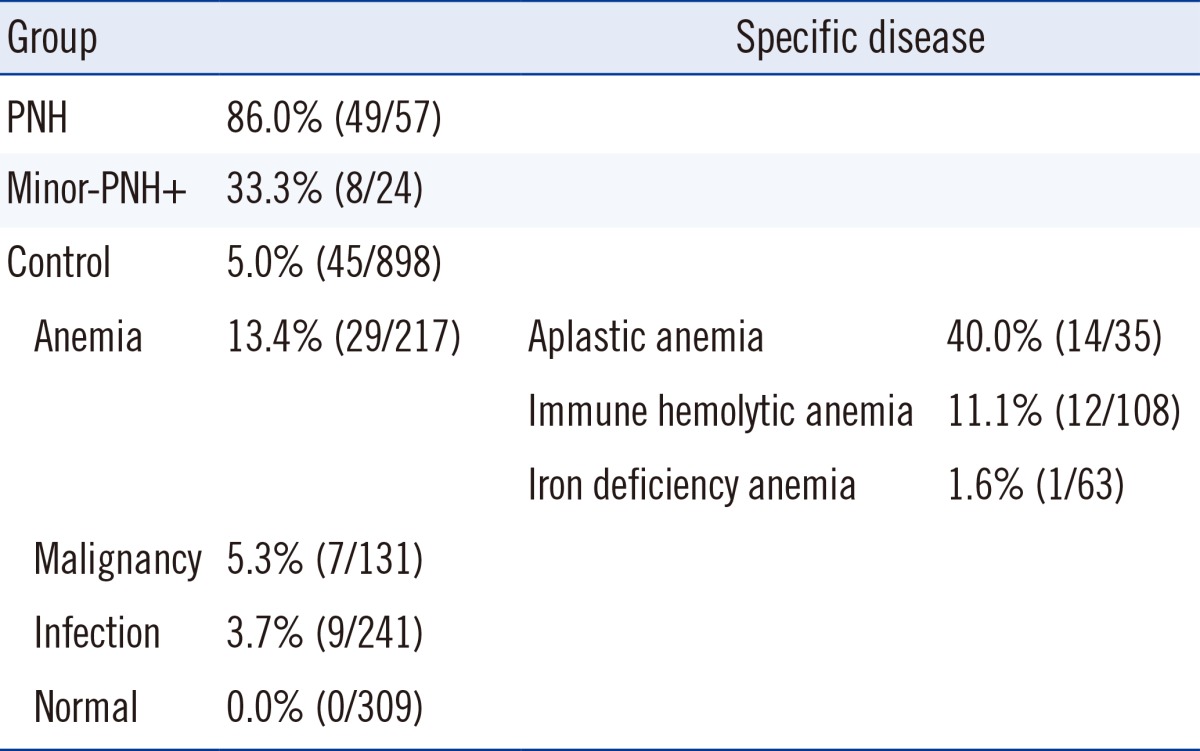1. Lee JW, Jang JH, Kim JS, Yoon SS, Lee JH, Kim YK, et al. Clinical signs and symptoms associated with increased risk for thrombosis in patients with paroxysmal nocturnal hemoglobinuria from a Korean Registry. Int J Hematol. 2013; 97:749–757. PMID:
23636668.

2. Takeda J, Miyata T, Kawagoe K, Iida Y, Endo Y, Fujita T, et al. Deficiency of the GPI anchor caused by a somatic mutation of the PIG-A gene in paroxysmal nocturnal hemoglobinuria. Cell. 1993; 73:703–711. PMID:
8500164.

3. Rosse WF, Ware RE. The molecular basis of paroxysmal nocturnal hemoglobinuria. Blood. 1995; 86:3277–3286. PMID:
7579428.

4. Rollins SA, Sims PJ. The complement-inhibitory activity of CD59 resides in its capacity to block incorporation of C9 into membrane C5b-9. J Immunol. 1990; 144:3478–3483. PMID:
1691760.
5. Parker CJ. Paroxysmal nocturnal hemoglobinuria: an historical overview. Hematology Am Soc Hematol Educ Program. 2008; 93–103. PMID:
19074065.

6. Brodsky RA, Hu R. PIG-A mutations in paroxysmal nocturnal hemoglobinuria and in normal hematopoiesis. Leuk Lymphoma. 2006; 47:1215–1221. PMID:
16923549.

7. Sugimori C, Mochizuki K, Qi Z, Sugimori N, Ishiyama K, Kondo Y, et al. Origin and fate of blood cells deficient in glycosylphosphatidylinositol-anchored protein among patients with bone marrow failure. Br J Haematol. 2009; 147:102–112. PMID:
19656154.

8. Raza A, Ravandi F, Rastogi A, Bubis J, Lim SH, Weitz I, et al. A prospective multicenter study of paroxysmal nocturnal hemoglobinuria cells in patients with bone marrow failure. Cytometry B Clin Cytom. 2014; 86:175–182. PMID:
24227693.

9. Ham TH, Dingle JH. Studies on destruction of red blood cells. II. Chronic hemolytic anemia with paroxysmal nocturnal hemoglobinuria: Certain immunological aspects of the hemolytic mechanism with special reference to serum complement. J Clin Invest. 1939; 18:657–672. PMID:
16694699.
10. Hartmann RC, Jenkins DE. The "sugar-water" test for paroxysmal nocturnal hemoglobinuria. N Engl J Med. 1966; 275:155–157. PMID:
5938862.

11. Brodsky RA. How I treat paroxysmal nocturnal hemoglobinuria. Blood. 2009; 113:6522–6527. PMID:
19372253.

12. Borowitz MJ, Craig FE, Digiuseppe JA, Illingworth AJ, Rosse W, Sutherland DR, et al. Guidelines for the diagnosis and monitoring of paroxysmal nocturnal hemoglobinuria and related disorders by flow cytometry. Cytometry B Clin Cytom. 2010; 78:211–230. PMID:
20533382.

13. Höchsmann B, Rojewski M, Schrezenmeier H. Paroxysmal nocturnal hemoglobinuria (PNH): higher sensitivity and validity in diagnosis and serial monitoring by flow cytometric analysis of reticulocytes. Ann Hematol. 2011; 90:887–899. PMID:
21359652.

14. Muñoz-Linares C, Ojeda E, Forés R, Pastrana M, Cabero M, Morillo D, et al. Paroxysmal nocturnal hemoglobinuria: a single Spanish center's experience over the last 40 yr. Eur J Haematol. 2014; 93:309–319. PMID:
24758317.
15. Hillmen P, Young NS, Schubert J, Brodsky RA, Socié G, Muus P, et al. The complement inhibitor eculizumab in paroxysmal nocturnal hemoglobinuria. N Engl J Med. 2006; 355:1233–1243. PMID:
16990386.

16. Brodsky RA, Young NS, Antonioli E, Risitano AM, Schrezenmeier H, Schubert J, et al. Multicenter phase 3 study of the complement inhibitor eculizumab for the treatment of patients with paroxysmal nocturnal hemoglobinuria. Blood. 2008; 111:1840–1847. PMID:
18055865.

17. Kelly RJ, Hill A, Arnold LM, Brooksbank GL, Richards SJ, Cullen M, et al. Long-term treatment with eculizumab in paroxysmal nocturnal hemoglobinuria: sustained efficacy and improved survival. Blood. 2011; 117:6786–6792. PMID:
21460245.

18. Park J, Lee H, Kim YK, Kim KH, Lee W, Lee KY, et al. Automated screening for tuberculosis by multiparametric analysis of data obtained during routine complete blood count. Int J Lab Hematol. 2014; 36:156–164. PMID:
24034225.

19. Urrechaga E. Clinical utility of the new Beckman-Coulter parameter red blood cell size factor in the study of erithropoiesis. Int J Lab Hematol. 2009; 31:623–629. PMID:
18771498.

20. Broséus J, Visomblain B, Guy J, Maynadié M, Girodon F. Evaluation of mean sphered corpuscular volume for predicting hereditary spherocytosis. Int J Lab Hematol. 2010; 32:519–523. PMID:
20136849.
21. Parker C, Omine M, Richards S, Nishimura J, Bessler M, Ware R, et al. Diagnosis and management of paroxysmal nocturnal hemoglobinuria. Blood. 2005; 106:3699–3709. PMID:
16051736.

22. Griscelli-Bennaceur A, Gluckman E, Scrobohaci ML, Jonveaux P, Vu T, Bazarbachi A, et al. Aplastic anemia and paroxysmal nocturnal hemoglobinuria: search for a pathogenetic link. Blood. 1995; 85:1354–1363. PMID:
7858265.

23. Yoshida N, Yagasaki H, Takahashi Y, Yamamoto T, Liang J, Wang Y, et al. Clinical impact of HLA-DR15, a minor population of paroxysmal nocturnal hemoglobinuria-type cells, and an aplastic anaemia-associated autoantibody in children with acquired aplastic anemia. Br J Haematol. 2008; 142:427–435. PMID:
18537977.
24. Scheinberg P, Wu CO, Nunez O, Young NS. Predicting response to immunosuppressive therapy and survival in severe aplastic anaemia. Br J Haematol. 2009; 144:206–216. PMID:
19036108.

25. Timeus F, Crescenzio N, Lorenzati A, Doria A, Foglia L, Pagliano S, et al. Paroxysmal nocturnal hemoglobinuria clones in children with acquired aplastic anaemia: a prospective single centre study. Br J Haematol. 2010; 150:483–485. PMID:
20456361.
26. Kulagin A, Lisukov I, Ivanova M, Golubovskaya I, Kruchkova I, Bondarenko S, et al. Prognostic value of paroxysmal nocturnal haemoglobinuria clone presence in aplastic anemia patients treated with combined immunosuppression: results of two-centre prospective study. Br J Haematol. 2014; 164:546–554. PMID:
24261566.
27. Sugimori C, Chuhjo T, Feng X, Yamazaki H, Takami A, Teramura M, et al. Minor population of CD55-CD59- blood cells predicts response to immunosuppressive therapy and prognosis in patients with aplastic anemia. Blood. 2006; 107:1308–1314. PMID:
16179371.






 PDF
PDF ePub
ePub Citation
Citation Print
Print






 XML Download
XML Download